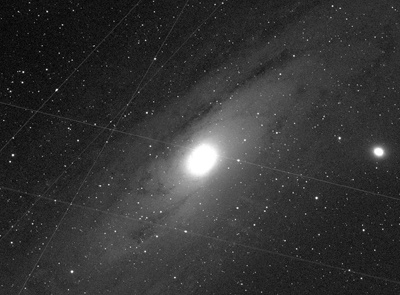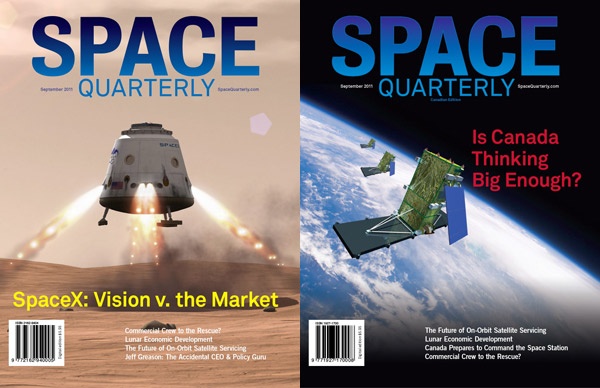You hear the talk about orbital crowding, but this one photograph, to me, helps illustrate the reality of it. It's not like people crammed into a subway, but when you think that these objects are flying around at thousands of kilometres per hour, you really hope they don't bump into each other..
Satellites in Shot, Blog (21 Nov 2011)
The image is a five-minute exposure of the Andromeda Galaxy, taken by top astrophotographer Nik Szymanek. But his photo has been blighted by FIVE satellites streaking across the field of view.
via SciBlogs (http://sciblogs.co.nz/open-parachute/2011/11/24/it’s-crowded-up-there/)
NZer captures first photos of another solar system, NZ Herald (28 Nov 2011)
Rolf Olsen, a New Zealand based astrophotographer, has published the first non-professional pictures of the disk of debris and dust swirling around Beta Pictoris, a very young solar system... Incredibly, the 12 million-year-old system was captured with only a 25cm telescope.
Rob Olsen's Website - http://www.pbase.com/rolfolsen/stars
{*}Mark Mackay will be attending the APRSAF-18 (Asia Pacific Regional Space Agency Forum) conference next week, which runs from 6-9 December 2011. KiwiSpace sent two representatives last year.{*}
While the formal parts of the conference can be a bit dry, but it's the working groups and networking opportunities that we're heading over for. We'll be focussing on the 'Space Education & Awareness' working group topics, and following up on the UNIFORM project (an Asia-Pacific cluster of micro-satellites) to see if there is an opportunity and any benefits for NZ to become involved.
Mark plans to provide updates on the @KiwiSpaceEvents twitter feed.
From talking to people lately, it's come to my attention that many people haven't heard about the new Space Quarterly magazine that was released in the US/Canada.
A free pilot issue released on September 1, and is available for free download now ... and i'm not sure for how much longer – so get your free copy now! I personally quite enjoyed this first issue, finding the articles quite interesting - and am very likely to subscribe (USD $19/year).
But I do have an ulterior motive behind this post – I'm keen to hear what you think should be in a New Zealand space magazine...
Over the past few weeks we've begun investigations into the viability of creating a space magazine for New Zealand. The idea came out of some brainstorming sessions about how to unify and amplify the efforts of the various astronomical and space-clubs around New Zealand. I won't bore you with details, but we're thinking that the magazine could be distributed free/cheaply through all the existing clubs and societies as an electronic PDF file, and if really successful – could become a proper newsstand publication.
Starting a magazine will take a lot of effort, but for the moment – let's assume that there is enough interest to make it viable:
And let me ask you – what would you want to read about in a local space magazine?
- What is it you really like about any newsletters/magazines you currently get from your local astronomy club/etc?
- What is missing – or what do you wish there was more coverage of? (particular topics/subject areas, types of news, etc?)
- Are there any international magazines you subscribe to, and why? What is worth the cost, or you feel is not being provided locally in the newsmedia?
And of course, if anyone is interested in getting involved with the discussions about creating the magazine, please get in touch with us. It's early days in our planning, but if we get enough support, we'll be needing contributing authors, designers, editors, etc.
Mark Mackay
Executive Director,
KiwiSpace Foundation
In April this year, KiwiSpace launched a helium-filled balloon to the 'edge of space' as part of our launch celebrations and the 50th anniversary of human spaceflight. This was a lot of fun, and resulted in some stunning photos being captured by the onboard camera. However the goal was always to go much further than this.
KiwiSpace has always wanted to develop an educational space balloon programme - providing students the opportunity to fly experiments to near-space and get involved with the process. This idea has been idling for a while, but we're keen to see if we can get this program underway, and need your help.
Our concept is quite fluid, and will depend a lot on what great ideas people come up with the for programme – but the base concept is something along the following lines:
Initial Concept
- KiwiSpace would develop and launch a balloon, likely from somewhere in the Waikato plains (we have members within driving distance, and we need a 'wide' section of NZ to avoid losing the balloon in the sea)
- The balloon would carry a core logistics payload of tracking equipment and cameras
- Additional experiment payloads could be suspended beneath this primary payload
- These payloads wouldn't need to deal with any tracking functions, as the core payload would handle that
- These payloads could potentially be a larger experiment payload, or perhaps clusters of smaller items such as 'pongsats'
So the plan would be to have students or institutions develop an experiment payload, send it into us, and we'd then launch it. The experiments would then be returned to the students for analysis ... assuming the balloon is recovered (which is an unfortunate risk).
In a perfect world, we'd like to get students involved with the 'chase' – the tracking and recovery of the balloon, but there are a number of problems with that unfortunately: Launch windows depend primarily on the weather. This can be difficult to predict, as it's the high-altitude winds which are important (not whether it's a sunny day). The launch team would likely need to respond with a day-or-two's 'preliminary notice', and then ultimately get a final go-ahead at around 2am on launch day... If all goes well, we'd launch at say 6-8am, and recover by noon. But it could go much longer, if the balloon lands in difficult terrain. And all of this, to me, makes it difficult to plan student/class involvement. That said, we can certainly provide online tracking.
The experiments
My current thinking is that we determine a standard 'payload' specification, along the lines of a 'Pongsat'.
This PongSat combines temperature, vibration, tilt and light sensors.
While small, it is possible to cram a reasonable amount of electronics into the size. But it is also possible to perform non-electronic experiments, such as:
- Whether a marshmallow puffs up in the vacuum of near-space
- What effect cosmic rays have on the growth of plant seeds
- Film cosmic ray experiment: Undeveloped film will often contain white streaks when developed after exposed to cosmic rays at high altitude
- Twin-pongsats: one beeps, the other listens. Sound can be used to determine altitude
- And there will be many more...
The pongsats, as they are self-contained could potentially just be suspended in a netted bag (for maximum atmospheric exposure), or in a separate insulated container.
In addition to this, custom experiments could be considered on a case-by-case basis.
Weight will ultimately be a deciding factor – the heavier the combined experiments, the slower the rise of the platform, or the need to go to a larger balloon - and much higher costs (helium is very expensive, although we are investigating hydrogen-fill as an option).
What are your thoughts?
So what do you think about this project concept?
- We'd love to hear from teachers who would be interested in participating in this type of program
- Are there any cool experiment ideas people can propose?
- Are there any good curriculum linkages we can emphasise?
- Is anyone interested in helping join a team to get this idea 'off the ground'?
- And as always, we'd love to hear from anyone who may be prepared to help in a financial capacity – especially if someone knows how to get free/sponsored helium!
Mark Mackay
Executive Director,
KiwiSpace Foundation.
NZ-originated company BigLittleBang has been named a 'rising star' in the Deloitte Fast 50 awards.
BigLittleBang featured in the 2011 World Space Week celebrations, and includes space-themed education areas for children to explore in a gaming environment.
BigLittleBang.com shoots for the stars!, scoop.co.nz (11 Nov 2011)
BigLittleBang.com is a safe online game that enables kids to be creative with music regardless of their musical background. Its objective is to encourage children of all ages to explore music via gaming in a 3D animated, futuristic space environment. Users can create their own unique avatar on the site, explore “planets” and make music with others online in real time. The site also offers a wide variety of safe social networking features.
Check out the website for more information: http://biglittlebang.com/.





